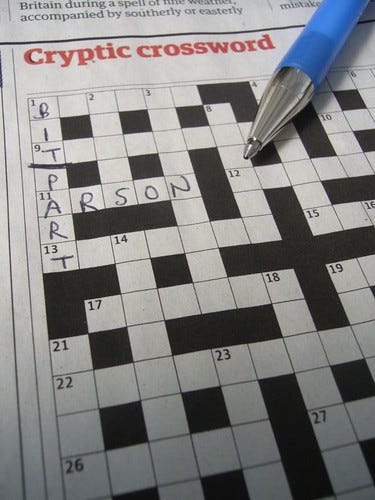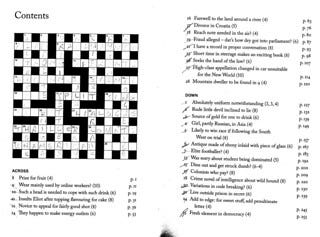This essay was written for the Soaring Twenties Social Club (STSC) Symposium. STSC members often create something around a set theme. This time the theme was “summer”.
If, like me, you have a love of language, you should explore the strange world of the cryptic crossword. Unlike the plain crossword, the cryptic variety requires more than providing a synonym for a word or phrase. Rather, it involves working out what the clue is getting at.
That sounds much more difficult than the task facing you in an ordinary crossword, doesn't it? In fact, much of the time it's easier, for one simple reason. In a plain crossword, you either know the answer or you don't. With a cryptic one, on the other hand, you have a chance of working the answer out from the clue. Indeed, on many occasions I have worked out the answer to be a word that I've never heard of, which means, of course, that I'd never have got the answer in a plain crossword setting.
Let me give you an example. Let's suppose the word to be entered into the grid is candle. In a normal crossword, the clue might be something like:
Type of illumination (6)1
In the hands of the cryptic cruciverbalist, however, the clue might read something like this:
It is wicked, but it gives light (6).
What's that you say? Wicked? What's good and bad got to do with it? Well actually, nothing, but before explaining why, I should deconstruct the sentence.
Like most cryptic clues, this consists of two parts: a definition, ie the meaning of the word or phrase that is the answer, and an indication of how to work the answer out. In this case, the definition is "it gives light". In other words, the answer is an object which gives light, so it could be a torch, candle, flare, sun, moon, neon light and so on. The indication part of the clue, though, helps us narrow it down by informing us that the object we're looking for is wicked, ie it has a wick.
That's a classic trick of the cryptic crossword clue: you mustn't take anything at face value! Here, the correct pronunciation of the word is not wick-ed but wick'd. Makes perfect sense, right?
Other examples include "flower", pronounced floe-er, ie something that flows, ie a river. Thus "Egyptian flower (4)" is not asking for the name of a plant, but the name of a river, ie the Nile.
Another example is “A little lower on the farm (4)”. Answer: Calf.
Or there’s the deceptively simple “Farm butter (4)”. Answer: Goat.
Perhaps an even worse example of this stretching the rules of language to their limit is the word "banker". That's not someone who works in the City or on Wall Street, but something that has banks, ie a river.
So perhaps you are wondering what on earth has any of this to do with the theme of ‘summer’. Simply this: in the world of the cryptic crossword, summer means someone who adds up, ie does sums. Similarly, an adder may not be a type of snake.
Here’s a little test. What do you understand by the word "detailed"? Well you're wrong. In the land of the cryptic crossword, "detailed" means having had its tail remove. That would usually mean that the end of the word has been removed.
So it won't surprise you to learn that "beheaded" means having had the first letter of the word removed.
Anagrams are indicated by a word or phrase which suggests the letters have been jumbled up: "all over the place"; "agitated"; "confused" and so on.
What makes the cryptic crossword especially challenging is that the clue makes sense in itself. That often leads the solver to make certain assumptions, and thereby to be led completely up the garden path. And the answer will often make you groan out loud, such as a clue I saw recently in the Daily Telegraph, which was something like:
"Is this the central part of our education system? (6,6)"
(A question mark usually indicates that there has been a complete mangling of the meaning of a word or phrase.)
The answer was "Middle School".
It's this sort of challenge and playfulness which makes cryptic crosswords fun to do.
My favourite crossword clue of all time appeared in the Daily Telegraph about 30 years ago. It read something like:
"What an incompetent deep sea diver must do to get rid of an irritation? (4,2,2,7)"
The answer? Come up to scratch.
To find out more about cryptic crosswords, you might also like to read this book, which interweaves crossword clues with the story:
Pretty Girl in Crimson Rose (8): A Memoir of Love, Exile and Crosswords2
The title is itself a cryptic crossword clue: "pretty girl" is "belle"; "crimson" is "red". Those are the clues provided for the definition, which is "rose" -- but not the flower, but the act of revolting against a a ruler. Hence the answer is "Rebelled", because you have to place the word "belle" (pretty girl) inside the word "red" (crimson).
This nicely illustrates the point I made earlier, about the clue making sense but thereby leading you in completely the wrong direction. When you read the sentence "Pretty girl in crimson rose", you are almost bound to conjure up a mental picture of an attractive young lady wearing a dress of a crimson rose colour. Completely wrong!
There is also the enigmatically titled Two Girls, One on Each Knee3, a book about how cryptic crosswords work. The image it conjures up seems to have very little to do with the recreational pursuit of solving a crossword. So, you need a bit of lateral thinking and logic to work your way through this one. What you’re trying to find out is the name of something people have on their knees. The two “girls” referred to are Pat and Ella, giving you “patella”.
This and other delightful snippets of information, along with copious advice about how to solve fiendish crossword clues, are to be found in this delightful book. Like its subject matter, the book is playful: the table of contents is itself in the form of a crossword, and even when you have solved the clues you are none the wiser as to the subject matter they refer to! Like some of the more extreme crosswords, solving the clues leads merely to further conundrums.
The joke is carried on throughout the book: when cross-referencing other chapters, the author says, for example, “See One Down”.
If you like doing crosswords, and love language, and wish to find out more about the history of crosswords and the various forms it takes, you will enjoy this book.
In conclusion, I would suggest that the best cryptic clues are the ones that make you groan out loud. For anyone who loves language, I highly recommend delving into the world of the cryptic crossword.
The number represents the number of letters in the answer.
Amazon affiliate link.
Ditto.




I love this. One might also describe the cryptic crossword as how a child might learn English. A six year old would be a helpful assistant as they would see the forge in forget or the flow in flower.
I love this Terry. You have given us super-helpful insights. No wonder I couldn't solve them. I had no idea what anything meant. I HAVE seen summer, butter and adder in standard puzzles, though. How about "nightlight rude gesture": m _ _ _